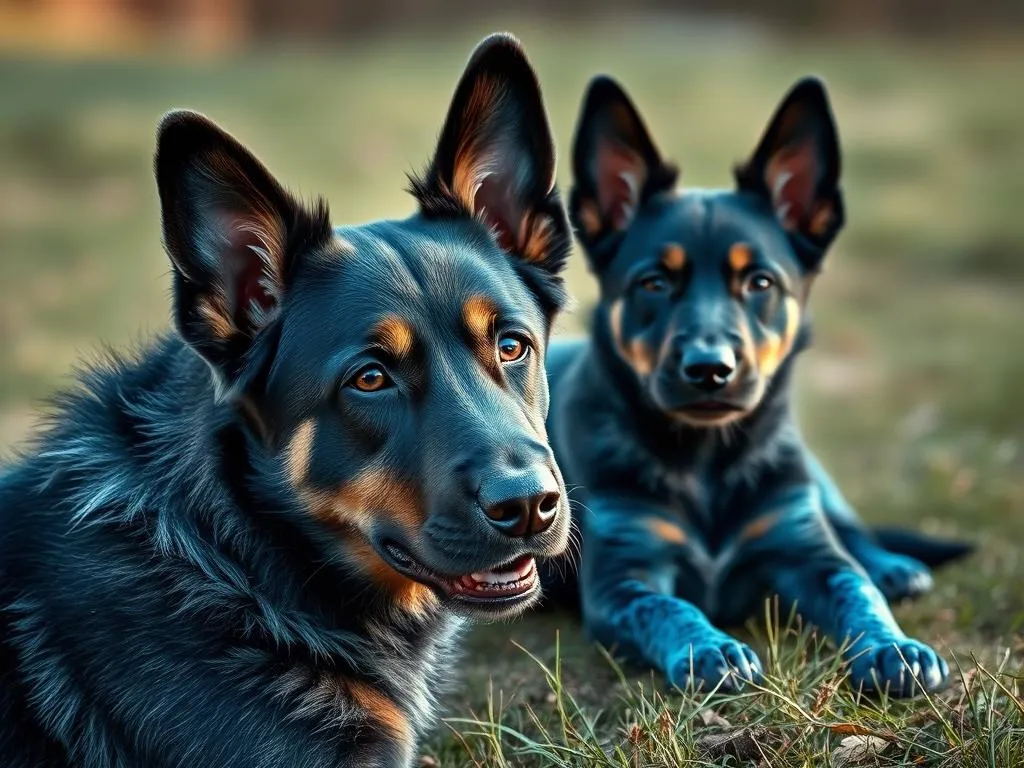
Introduction
Blue Heelers, also known as Australian Cattle Dogs, are a remarkable breed known for their intelligence, agility, and unique coloring. Originating from Australia, these dogs have a rich history as herding animals, specifically bred for managing cattle and livestock. This article aims to explore the characteristics, color variations, and common misconceptions surrounding Blue Heelers, particularly the intriguing question: are Blue Heelers really blue?
Understanding the breed is essential for potential owners and enthusiasts alike, as it provides insight into their behavior, care needs, and distinctive traits.
Understanding Blue Heelers
History and Origin
The development of the Blue Heeler traces back to 19th-century Australia, where early settlers required a dog that could effectively herd cattle across vast distances. The breed was primarily developed by crossing the native Dingo with various herding breeds, including the Collie and the Dalmatian. This combination resulted in a breed that was not only intelligent but also highly trainable and resilient.
Key historical figures, such as Thomas Hall, played a crucial role in the breed’s establishment. Hall’s efforts led to the refinement of the Blue Heeler, emphasizing traits like stamina, agility, and a strong work ethic. As a result, the Blue Heeler became a staple on farms and ranches, known for its ability to manage livestock in challenging conditions.
Physical Characteristics
Blue Heelers are medium-sized dogs, typically weighing between 30 to 50 pounds and standing about 17 to 20 inches tall at the shoulder. They are well-proportioned, with a muscular build that reflects their working heritage.
Their coat is short, dense, and weather-resistant, designed to protect them from the elements while they work outdoors. Common color patterns include blue and red, with the blue variety often exhibiting a striking mottled or speckled appearance. The term “blue” in this context can be somewhat misleading, as it refers to a greyish-blue hue rather than a bright blue.
Temperament and Personality
Blue Heelers are known for their high energy levels and intelligence. They are incredibly loyal and protective of their families, making them excellent companions. Their herding instinct can manifest in various behaviors, such as nipping or chasing, so early socialization and training are essential.
These dogs thrive on mental and physical challenges, which means they are best suited for active families or individuals who can provide them with the stimulation they need. They are known to bond closely with their owners and can be very affectionate, making them great family pets if their needs are met.
Are Blue Heelers Really Blue?
The Color Blue Explained
To answer the question, are Blue Heelers really blue, we first need to define what “blue” means in the context of dog breeding. In the case of Blue Heelers, “blue” refers to a specific color that can range from a light steel blue to a darker slate. This coloration results from a genetic dilution of the black pigment, which gives the coat its unique appearance.
Genetics play a significant role in determining coat color among Blue Heelers. The presence of specific genes can influence whether a dog will exhibit a blue or red coat. While blue is the more recognized color, the breed also includes red Heelers, which have a more traditional reddish-brown coat.
Common Color Variations
While the standard blue color is widely recognized, there are several variations within the Blue Heeler spectrum.
- Blue Heeler: The most common color, which features a range of blue shades, often with mottling or speckling.
- Red Heeler: A distinct variety that displays a reddish coat, typically with white markings.
- Speckled or Mottled: Some Blue Heelers exhibit a blend of colors, resulting in a speckled or mottled appearance that combines both blue and white or red and white.
Understanding these color variations helps clarify why the breed’s name can be misleading. Not all Blue Heelers are purely blue, and potential owners should be aware of the differences.
Misconceptions About the Color
Many misconceptions exist regarding the coloration of Blue Heelers. One common myth is that all Blue Heelers are a vibrant blue color. In reality, the shade can vary significantly based on genetics, age, and even seasonal changes in coat appearance.
Another misconception is that the breed is entirely distinct from Red Heelers. While they are considered different variations, they belong to the same breed and share many characteristics.
Understanding these nuances helps prospective owners appreciate the breed’s diversity and avoid potential confusion when selecting a Blue Heeler.
Caring for a Blue Heeler
Grooming Needs
Caring for a Blue Heeler involves regular grooming to maintain their coat’s health and appearance. Generally, these dogs have low grooming requirements, making them relatively easy to care for.
- Frequency: Regular brushing, at least once a week, helps to remove loose hair and dirt.
- Techniques: Use a slicker brush or a rubber curry brush to effectively manage their coat.
- Tools and Products: A good quality dog shampoo and conditioner can keep their coat healthy, especially after outdoor adventures.
Seasonal shedding may occur, particularly in spring and fall, where more frequent brushing may be necessary to manage loose fur.
Exercise Requirements
Blue Heelers are active dogs that require substantial daily exercise to stay healthy and happy.
- Daily Needs: They typically need at least 60 to 90 minutes of physical activity each day, which can include walks, runs, or playtime in the yard.
- Mental Stimulation: Alongside physical exercise, providing mental challenges is crucial. Puzzle toys, agility training, and obedience training can keep their minds engaged.
- Recommended Activities: Activities such as fetch, frisbee, or herding trials can be particularly enjoyable for Blue Heelers, allowing them to utilize their natural instincts.
Failing to meet their exercise needs can result in behavioral issues, such as excessive barking or destructive tendencies.
Health Considerations
Like all breeds, Blue Heelers can be prone to certain health issues. Some common health considerations include:
- Hip Dysplasia: A genetic condition that can affect mobility and comfort.
- Deafness: Some Blue Heelers may be prone to congenital deafness, which can impact training.
- Eye Problems: Conditions such as cataracts or progressive retinal atrophy may occur.
Regular veterinary check-ups are essential for early detection and management of potential health problems. Preventive measures, including a balanced diet, regular exercise, and maintaining a healthy weight, can significantly enhance their quality of life.
Training and Socialization
Basic Training Techniques
Training a Blue Heeler requires consistency, patience, and positive reinforcement. These intelligent dogs thrive on structure and respond well to clear commands. Effective training techniques include:
- Positive Reinforcement: Reward-based training encourages desired behaviors through praise or treats.
- Consistency: Use the same commands and signals to avoid confusion.
- Common Commands: Teaching basic commands like “sit,” “stay,” “come,” and “heel” is essential for good behavior.
Training should be a fun and rewarding experience for both the dog and the owner, helping to strengthen their bond.
Socialization Tips
Early socialization is critical for Blue Heelers to develop into well-adjusted adults. Proper exposure to various environments, people, and pets can prevent behavioral issues down the line.
- Importance of Socialization: It helps them learn appropriate behaviors and reduces anxiety in new situations.
- Recommended Activities: Puppy classes, playdates with other dogs, and visits to parks can provide valuable social experiences.
- Introducing to New Environments: Gradually exposing your Blue Heeler to new sights, sounds, and smells can help them adapt and thrive in different settings.
By prioritizing socialization, owners can raise a confident and friendly Blue Heeler.
Conclusion
In conclusion, Blue Heelers are a unique and fascinating breed with a rich history, distinct characteristics, and a variety of color options. Understanding the nuances of their coloration and the care they require is crucial for anyone considering adding a Blue Heeler to their family.
While the question are Blue Heelers really blue can be answered with a resounding “not entirely,” the blend of colors and patterns only adds to their charm. With proper training, socialization, and care, these dogs can become loyal companions and valuable members of any household.
FAQs
What is the lifespan of a Blue Heeler?
Blue Heelers typically live between 12 to 15 years, depending on genetics and overall health.
Can Blue Heelers be apartment dogs?
While they can adapt to apartment living, they require ample exercise and mental stimulation to thrive.
Are Blue Heelers good with children?
Yes, Blue Heelers can be good with children, especially if they are properly socialized from a young age.
How much exercise do Blue Heelers need daily?
Blue Heelers require at least 60 to 90 minutes of exercise each day to stay healthy and happy.
What should I feed my Blue Heeler?
A balanced diet of high-quality dog food, appropriate for their age, size, and activity level, is essential for maintaining their health.









